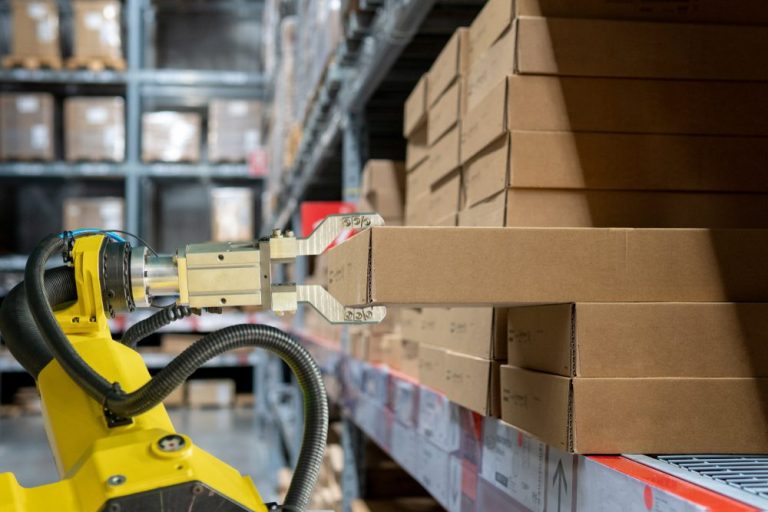This is as CFOs face ongoing inflationary pressures and high labor costs, and companies are increasingly looking to modernize their back-end operations and repurpose capital spending toward internal and customer-facing initiatives that help control costs and drive sustainable efficiency.
While the pandemic highlighted cracks in traditional approaches to accounting and logistics, it also spurred the creation of a next-generation suite of emergent omnichannel tools to help organizations accelerate the agility and effectiveness of their business processes through innovative, digitally powered — and frequently automated — solutions.
Automated Factories, Robotic Fulfillment Centers
Across the marketplace, for example, savvy retail finance leaders are developing autonomous “hubs” powered by integrated robotic solutions that streamline operations and cut costs while helping meet a new generation of customer expectations around frictionless, repeatable delivery experiences.
Driven by ongoing disruptions in the global supply chain and an increasingly choppy labor market, businesses are updating their organizational footprint to better leverage automated storage, retrieval and sorting systems that reduce the time employees spend finding, picking, packing and shipping products to customers.
Advertisement: Scroll to Continue
This new generation of automated fulfillment hubs reduces transaction costs, gives companies more oversight on production and even has the potential to power more ethical and sustainable supply chains.
One example is pet retailer Chewy, betting on automated fulfillment centers to curb rising labor costs by reducing the time its warehouse pickers and packers spend sorting and filling customer orders.
“When we think about the future of our fulfillment network, automation is at the center of that,” Chewy CFO Mario Marte said. “It lowers the cost, it improves safety, it increases capacity.”
As PYMNTS reported last month, automated fulfillment represents “a compelling next-step evolution for retailers,” or at least for larger retailers.
Robotic solutions for warehouse tasks are already beginning to shift the balance of power in fulfillment centers from machines supporting people to, eventually, people supporting machines.
In particular, Amazon is both leaning on and leveraging robotic fulfillment management solutions to provide its vast audience of eCommerce customers with a convenient and efficient purchase and delivery journey. The company said its tech-powered approach has already created over 700 new categories of jobs.
Amazon rival Walmart is, in turn, taking to the skies as it looks to solve fulfillment stress points. As reported by PYMNTS, the omnichannel retail giant is actively exploring how to meet the unique challenges of a rising retail landscape where rather than drive to the big-box brand’s many storefronts, shoppers increasingly make their purchases online and expect those orders to show up seamlessly at their doorsteps, by deploying a fleet of autonomous drones to make deliveries.
In an update last week (Jan. 5), Walmart reported that its early lead in autonomous drone deliveries amounted to more than 6,000 deliveries across seven states and three dozen stores.
While it may appear at first glance that integrating these automated solutions requires a heavy technical and capital expenditure lift, by taking a strategically tiered-and-timed approach to onboard next-generation automated technologies, businesses can manage this evolution in a lock-step fashion that consistently adds both operational and labor-saving value.
It is important to view the tools of tomorrow as a way to accrue efficiencies across existing processes rather than as a total nuts-and-bolts replacement that throws the baby out with the bathwater.
Automating Financials
The accounts receivable (AR) and accounts payable (AP) offices are often complex, paper-based and filled with legacy hurdles and other systemic mismatches that frustrate third-party vendors and suppliers.
Automated artificial intelligence (AI) and machine-learning tools are already being turned to and deployed as a key solution for the more manual and mundane tasks across many payments, banking and financial activities as organizations realize the benefits they offer across combatting fraud, underwriting credit, managing cash flow and more.
As intelligent, automated solutions grow “smarter,” their use cases will only become more attractive to businesses looking for operational wins in solving long-standing challenges or friction points.
AI is the best tool for automating the previously manual tedium of parsing large financial data sets. PYMNTS recently reported that intelligent AI tools are already being deployed to help finance teams deal with the current accountant staffing shortage, taking on the more onerous, repetitive back-office tasks and freeing up human finance teams to think “less like bookkeepers, and more like businesspeople.”
Per the article, studies project that over the next three years, nearly half of all business-to-business (B2B) invoices will be issued, processed and paid without human intervention.
It will be interesting to see how 2023 unfolds as automated solutions take hold and gain ground in the connected economy.
For all PYMNTS B2B coverage, subscribe to the daily B2B Newsletter.

